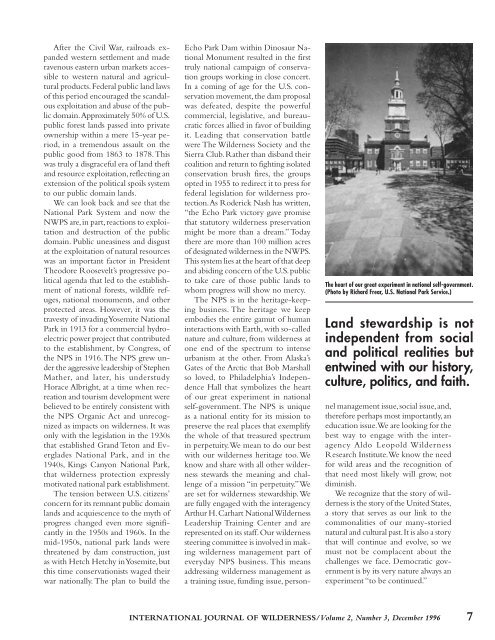P3-Vol 2.No3 Dec 96 - International Journal of Wilderness
P3-Vol 2.No3 Dec 96 - International Journal of Wilderness
P3-Vol 2.No3 Dec 96 - International Journal of Wilderness
You also want an ePaper? Increase the reach of your titles
YUMPU automatically turns print PDFs into web optimized ePapers that Google loves.
After the Civil War, railroads expanded<br />
western settlement and made<br />
ravenous eastern urban markets accessible<br />
to western natural and agricultural<br />
products. Federal public land laws<br />
<strong>of</strong> this period encouraged the scandalous<br />
exploitation and abuse <strong>of</strong> the public<br />
domain. Approximately 50% <strong>of</strong> U.S.<br />
public forest lands passed into private<br />
ownership within a mere 15-year period,<br />
in a tremendous assault on the<br />
public good from 1863 to 1878. This<br />
was truly a disgraceful era <strong>of</strong> land theft<br />
and resource exploitation, reflecting an<br />
extension <strong>of</strong> the political spoils system<br />
to our public domain lands.<br />
We can look back and see that the<br />
National Park System and now the<br />
NWPS are, in part, reactions to exploitation<br />
and destruction <strong>of</strong> the public<br />
domain. Public uneasiness and disgust<br />
at the exploitation <strong>of</strong> natural resources<br />
was an important factor in President<br />
Theodore Roosevelt’s progressive political<br />
agenda that led to the establishment<br />
<strong>of</strong> national forests, wildlife refuges,<br />
national monuments, and other<br />
protected areas. However, it was the<br />
travesty <strong>of</strong> invading Yosemite National<br />
Park in 1913 for a commercial hydroelectric<br />
power project that contributed<br />
to the establishment, by Congress, <strong>of</strong><br />
the NPS in 1916. The NPS grew under<br />
the aggressive leadership <strong>of</strong> Stephen<br />
Mather, and later, his understudy<br />
Horace Albright, at a time when recreation<br />
and tourism development were<br />
believed to be entirely consistent with<br />
the NPS Organic Act and unrecognized<br />
as impacts on wilderness. It was<br />
only with the legislation in the 1930s<br />
that established Grand Teton and Everglades<br />
National Park, and in the<br />
1940s, Kings Canyon National Park,<br />
that wilderness protection expressly<br />
motivated national park establishment.<br />
The tension between U.S. citizens’<br />
concern for its remnant public domain<br />
lands and acquiescence to the myth <strong>of</strong><br />
progress changed even more significantly<br />
in the 1950s and 1<strong>96</strong>0s. In the<br />
mid-1950s, national park lands were<br />
threatened by dam construction, just<br />
as with Hetch Hetchy in Yosemite, but<br />
this time conservationists waged their<br />
war nationally. The plan to build the<br />
Echo Park Dam within Dinosaur National<br />
Monument resulted in the first<br />
truly national campaign <strong>of</strong> conservation<br />
groups working in close concert.<br />
In a coming <strong>of</strong> age for the U.S. conservation<br />
movement, the dam proposal<br />
was defeated, despite the powerful<br />
commercial, legislative, and bureaucratic<br />
forces allied in favor <strong>of</strong> building<br />
it. Leading that conservation battle<br />
were The <strong>Wilderness</strong> Society and the<br />
Sierra Club. Rather than disband their<br />
coalition and return to fighting isolated<br />
conservation brush fires, the groups<br />
opted in 1955 to redirect it to press for<br />
federal legislation for wilderness protection.<br />
As Roderick Nash has written,<br />
“the Echo Park victory gave promise<br />
that statutory wilderness preservation<br />
might be more than a dream.” Today<br />
there are more than 100 million acres<br />
<strong>of</strong> designated wilderness in the NWPS.<br />
This system lies at the heart <strong>of</strong> that deep<br />
and abiding concern <strong>of</strong> the U.S. public<br />
to take care <strong>of</strong> those public lands to<br />
whom progress will show no mercy.<br />
The NPS is in the heritage-keeping<br />
business. The heritage we keep<br />
embodies the entire gamut <strong>of</strong> human<br />
interactions with Earth, with so-called<br />
nature and culture, from wilderness at<br />
one end <strong>of</strong> the spectrum to intense<br />
urbanism at the other. From Alaska’s<br />
Gates <strong>of</strong> the Arctic that Bob Marshall<br />
so loved, to Philadelphia’s Independence<br />
Hall that symbolizes the heart<br />
<strong>of</strong> our great experiment in national<br />
self-government. The NPS is unique<br />
as a national entity for its mission to<br />
preserve the real places that exemplify<br />
the whole <strong>of</strong> that treasured spectrum<br />
in perpetuity. We mean to do our best<br />
with our wilderness heritage too. We<br />
know and share with all other wilderness<br />
stewards the meaning and challenge<br />
<strong>of</strong> a mission “in perpetuity.” We<br />
are set for wilderness stewardship. We<br />
are fully engaged with the interagency<br />
Arthur H. Carhart National <strong>Wilderness</strong><br />
Leadership Training Center and are<br />
represented on its staff. Our wilderness<br />
steering committee is involved in making<br />
wilderness management part <strong>of</strong><br />
everyday NPS business. This means<br />
addressing wilderness management as<br />
a training issue, funding issue, person-<br />
The heart <strong>of</strong> our great experiment in national self-government.<br />
(Photo by Richard Frear, U.S. National Park Service.)<br />
Land stewardship is not<br />
independent from social<br />
and political realities but<br />
entwined with our history,<br />
culture, politics, and faith.<br />
nel management issue, social issue, and,<br />
therefore perhaps most importantly, an<br />
education issue. We are looking for the<br />
best way to engage with the interagency<br />
Aldo Leopold <strong>Wilderness</strong><br />
Research Institute. We know the need<br />
for wild areas and the recognition <strong>of</strong><br />
that need most likely will grow, not<br />
diminish.<br />
We recognize that the story <strong>of</strong> wilderness<br />
is the story <strong>of</strong> the United States,<br />
a story that serves as our link to the<br />
commonalities <strong>of</strong> our many-storied<br />
natural and cultural past. It is also a story<br />
that will continue and evolve, so we<br />
must not be complacent about the<br />
challenges we face. Democratic government<br />
is by its very nature always an<br />
experiment “to be continued.”<br />
INTERNATIONAL JOURNAL OF WILDERNESS/<strong>Vol</strong>ume 2, Number 3, <strong>Dec</strong>ember 19<strong>96</strong> 7










